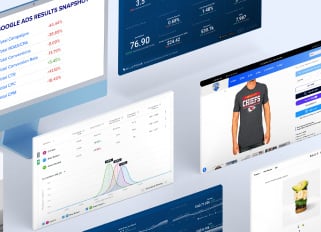
E-commerce Conversion Rate Optimization: Ultimate Guide to Boost Online Store
In the fast-paced world of e-commerce, simply attracting visitors to your website isn't enough. Conversion rate optimization (CRO) is the key to transforming those visitors into paying customers. A well-executed CRO strategy can significantly boost your sales and set your online store apart from the competition.
Did you know that a mere 1% increase in conversion rate can lead to substantial revenue growth? That's why it's essential for e-commerce businesses to pay attention to their conversion rate and continuously work towards improving it.
In this guide, we'll cover everything you need to know about e-commerce conversion rate optimization, from understanding the basics to implementing effective strategies for your ecommerce store.
Let’s get started…
What is Conversion Rate Optimization (CRO)?
Conversion rate optimization is the process of optimizing a website or landing page to increase the percentage of site visitors who take a desired action, such as making a purchase or signing up for a newsletter.
Effective CRO requires a thorough analysis of data and the implementation of various techniques within the conversion funnel to improve user experience and, ultimately, increase conversions. This also includes monitoring key metrics such as click-through rates, bounce rates, and average time on page to assess the effectiveness of implemented strategies.
A common misconception about CRO is that it solely focuses on increasing sales. While it does contribute to revenue growth, it also prioritizes enhancing overall user experience and satisfaction. Creating a smooth and enjoyable customer journey can build trust and loyalty with your target audience, resulting in repeat purchases and brand advocacy.
Why is CRO Important for E-commerce?
As an e-commerce business, your primary objective is to drive sales. A high conversion rate indicates more visitors are engaging with your website and purchasing your products or services. Industry reports show that e-commerce stores focusing on conversion rate optimization (CRO) experience an average sales increase of 10-30%. By enhancing your conversion rate, you can achieve greater revenue and profits without needing to boost website traffic.
Furthermore, in an increasingly competitive e-commerce landscape, a strong conversion rate can provide a significant advantage over your rivals. It enables you to maximize the value of your existing traffic and distinguish yourself in a crowded marketplace.
Ecommerce Conversion Rate Benchmarks
According to industry leaders, average e-commerce conversion rates typically range from 2.5% to 3%. While this benchmark is useful, it shouldn't be seen as the ultimate target for your business. Continuous optimization of your conversion rate through various strategies is essential.
A recent survey by the Shopify analytics app LittleData reveals that the average conversion rate for Shopify stores is 1.4%. If your conversion rate dips below 0.5%, it clearly indicates there’s significant room for improvement. Conversely, if you exceed a conversion rate of 3.3%, you are performing exceptionally well, placing your store in the top 20% of all Shopify sites.
Being aware of these benchmarks is crucial for your success. By analyzing your conversion rate against industry averages, you’ll gain valuable insights into your e-commerce website’s performance and can make informed decisions to enhance your business.
How to Get Started with CRO for Your E-commerce Store
Now that you understand the importance of conversion rate optimization for your e-commerce store, let's dive into how to implement it.
1. Analyze Your Data
The first step towards successful CRO is analyzing data from various sources such as Google Analytics, heat maps, user behavior reports, etc. This will help you understand how users are interacting with your website and where they may be dropping off in the conversion process. This data will allow you to identify potential issues and areas for improvement.
To effectively optimize your e-commerce store's conversion rate, it is essential to collect and analyze different types of data. The two main categories are quantitative data and qualitative data, each providing distinct insights that can guide your site’s conversion rate optimization (CRO) strategies.
Quantitative Data
Quantitative data is numerical and is typically gathered through tools such as Google Analytics. This data type includes metrics like page view counts, conversion rates, bounce rates, and average session duration.
Qualitative Data
Qualitative data provides insights into the reasons behind user behaviors. It is collected through customer surveys, interviews, and usability tests. This type of data helps you understand the motivations, preferences, and potential frustrations of your users.
Incorporating both quantitative and qualitative data into your CRO efforts ensures a comprehensive understanding of your e-commerce store's performance and user experience, leading to more effective optimization strategies.
2. Improve User Experience
One of the crucial steps to boosting ecommerce conversions is understanding the customer journey. Consider the seamless browsing experience on Apple’s homepage or the effortless checkout process when shopping on Amazon, whether on desktop or mobile. That’s the power of exceptional UX design.
How easily can your users navigate your ecommerce site? Are you ensuring their experience is as enjoyable and straightforward as possible? Are you providing the same high-quality experience for both mobile and desktop users? You must address these vital questions if you’re serious about optimizing the customer journey.
Now, let’s explore a few other key factors that can influence user experience and may be worth optimizing:
Page Speed
According to Google research, as page load time goes from 1 second to 3 seconds, the likelihood of a bounce increases by 32%. Furthermore, Nearly half of consumers (47%) expect websites to load in 2 seconds or less, while 40% are likely to abandon a site that takes more than 3 seconds to load. With these statistics in mind, it’s easy to see why optimizing your website's speed is crucial for improving conversions.
If you'd like to check your page speed, you can do that by using this free Google application.
 Mobile Responsiveness
Mobile Responsiveness
With mobile devices driving over half of global web traffic and more people shopping on their smartphones than ever before, having a responsive design is no longer an option - it’s essential! Ensure that your e-commerce store has a user-friendly mobile design so customers can easily shop from any device.
3. Optimize Your Homepage and Landing Pages
Your homepage and landing pages are often the first touchpoints for potential customers and, therefore, play a crucial role in converting visitors into buyers. These pages should be visually appealing, easy to navigate, and relevant to your target audience.
Here are some tips for optimizing your homepage and landing pages:
Clear and Compelling Value Proposition
Your value proposition is what sets you apart from your competitors and should be prominently displayed on your homepage and landing pages. It should clearly state the benefits of your products or services and why customers should choose you over others.
High-Quality Visuals
Visuals such as high-resolution product images, videos, and interactive elements can significantly impact a user’s purchase decision. Be sure to, invest in professional photography or graphic design to ensure your visuals are eye-catching and appealing.
Clear Call-to-Action (CTA)
A clear call-to-action tells users what action they need to take next, whether it’s “Shop Now,” “Sign Up,” or “Learn More.” Make sure your CTA stands out and is easily visible on the page. It should also be relevant to the content on the page and aligned with your overall conversion goals.
4. Optimize Your Product Pages
Your product pages are crucial to your conversion optimization strategy. These pages serve as a vital resource for shoppers, offering detailed information about specific products or services, as well as insights into your brand. It's essential to include all the necessary details here to help customers make informed purchasing decisions.
Write Killer Product Descriptions
Crafting compelling product descriptions starts with applying copywriting principles such as good storytelling and magnetic headlines. Focus on highlighting the benefits while keeping your language clear and engaging.
Use High-Quality Images and Videos
Images and videos are powerful visual elements that can significantly influence a user's decision to purchase. Use high-quality and multiple product images and videos to showcase your products in action, giving customers a better understanding of what they're buying.
Include Customer Reviews and Ratings
Social proof is a crucial factor in building trust with potential customers and encouraging them to convert. Incorporating customer reviews and ratings on your product pages can boost sales and credibility and provide valuable feedback for potential buyers.
Utilize SEO Best Practices
Implement search engine optimization (SEO) best practices by including target keywords in product titles, descriptions, and metadata. Use structured data markup to enhance listings in search result pages. These actions improve product visibility and attract more organic traffic to your site.
By focusing on these elements, you can create product pages that inform, engage, and convert visitors into satisfied customers.
5. Simplify Your Checkout Process
Simplifying your checkout process is paramount to reducing cart abandonment and enhancing customer satisfaction. Here are some strategies for refining this vital step of the eCommerce journey:
Streamline the Checkout Steps
Minimize the number of steps required to complete a purchase. A single-page checkout or a clear progress bar indicator can make the process feel quicker and more manageable.
Enable Guest Checkout
Forcing users to create an account before purchasing can deter potential customers. Allow guest checkout options to improve conversion rates while gently encouraging account creation post-purchase for benefits like order tracking or expedited future purchases.
Simplify Form Fields
Limit form fields to essential information only. Use auto-fill and validation features for convenience, and ensure fields are clearly labeled for user ease.
Provide Multiple Payment Options
Offering a wide range of payment methods caters to varying customer preferences, including credit cards, digital wallets, and local payment solutions. This flexibility can significantly impact a customer's decision to proceed with a purchase.
Clearly Display Shipping Costs and Timelines
Transparency in shipping costs and expected delivery times can reduce cart abandonment. Clearly outline all costs upfront and consider offering free shipping options when feasible.
Integrate Trust Signals
Incorporate security badges, customer testimonials, or refund policies within the checkout page to build credibility and assure customers of their purchase safety.
By implementing these strategies, your checkout process can significantly contribute to a smooth, satisfying, and secure shopping experience, ultimately driving higher sales conversions.
6. A/B Testing
Finally, conducting A/B testing on different elements of your website is crucial for constant optimization. A/B testing, also known as split testing, is a method of comparing two versions of a webpage to determine which performs better. This can help identify areas for improvement and optimize your website based on data-driven insights.
The duration of your test and the timing of your analysis ultimately depend on your preferences. As a general guideline, running tests for a minimum of three weeks to a month is advisable before making decisions based on the results.
Note: A longer test period can lead to more accurate and reliable outcomes.
As you review your results, take a moment to consider the following questions:
- Was the original version more effective?
- Did the second variation prove to be superior?
- Did both versions have shortcomings?
- In what areas did they both fall short?
- Did they both underperform?
- Were there any external factors, such as seasonality, that influenced the results?
BlueTuskr Your CRO Partner
At BlueTuskr, we understand the importance of CRO in driving business success. Our team of experts can help you identify areas for improvement and implement effective strategies to boost your conversion rates. With our proven methodologies and data-driven approach, we can help you optimize your website for maximum performance. Contact us today to learn more!
Conclusion
Improving your e-commerce website is an ongoing journey that requires your attention and regular evaluation to boost conversions. It's all about experimenting with various elements and discovering what resonates with your customers. Effective CTAs, engaging product descriptions, a streamlined checkout process, and A/B testing are great starting points. Remember, consumer preferences shift over time, so it's crucial to keep reassessing and adapting your strategies.
So, keep experimenting, stay informed on the latest trends and technologies, and partner with experts like BlueTuskr to drive sustainable business growth through CRO.
Connect With Us
Recent Post

.png)




Tell us what you think!